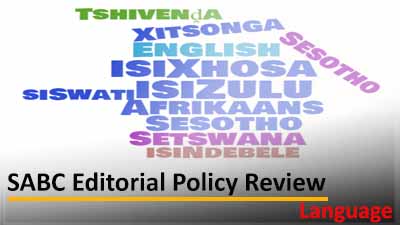.
Current Policies: Language
Q: What is the SABC commitment in respect of broadcasting in all of cial languages?
The main commitments are to:
• Provide a range of distinctive, creative and top quality programmes in all 11 of cial languages across our radio and television portfolio, and strive to re ect the needs of each language community in our programming
• Maintain distinct and separate radio services in each of the 11 of cial languages
• Treat all the of cial languages equitably on our television services
• Integrate South Africa Sign Language into broadcasting as a means of making programming accessible to people with hearing disabilities
• Strive to include other non-of cial languages spoken in South Africa, with particular emphasis on the Khoi, Nama and San languages.
Q: What is our position on non-of cial languages and sign language?
The SABC commits itself to providing quality radio programmes in non-of cial South African languages, in particular in the Khoi, Nama and San languages. The SABC progressively expands the amount of programming that is signed, beginning with selected news and current affairs, and events of national importance. Special efforts are being made to provide Sign Language interpretation when programmes are recorded in front of live audiences.
Q: What does “equitable treatment “of languages mean?
The term equitable means just, fair and reasonable — not necessarily equal — treatment.
In this regard, the SABC aims to broadcast every of cial language on television, while ensuring that programmes are accessible to as many viewers as possible. We aim to complement our national television service by providing regional services as required by the Broadcasting Act, (as amended) pending the licensing of these services by ICASA and appropriation of funds for this purpose, by Parliament. Equitability is achieved through a combination of means, including unilingual productions and multilingual programmes. We strive to explore the use of technologies such as subtitling to ensure that programmes are accessible to as many viewers as possible. At times this objective is met the best by broadcasting in cognate or widely understood languages. When this is applied, the SABC rotates the use of languages in any cognate group in order to achieve equitability.
Q: What is our approach on multilingual broadcasting?
The SABC is conscious of the part multilingual programmes can play in promoting knowledge and understanding of the country’s diversity of languages and cultures. Such programmes, when used creatively, also reach out to wider audiences. Accordingly, the SABC actively encourages production of meaningful multilingual programmes as a means of attaining its language broadcasting objectives. Multilingual programmes are those that include substantial amounts of more than one of cial language.
Q: Which South African languages are recognised in the policies as more marginalized than others?
XiTsonga, TshiVenda, SiSwati and isiNdebele are recognised as being more marginalised than the others and there is an additional responsibility on institutions such as the SABC to address this marginalization.
Q: What factors are taken into account when deciding how much time each language gets on television?
In determining allocation of time to each language, the SABC has due regard to:
• The number of home language speakers in the coverage area of a channel
• The geographical spread of the language
• The extent to which members of a language community are able to understand other languages.
• The extent of marginalisation of the language
• The extent to which it is understood by other South Africans
• Available resources.
Review: Language
• Are the above (& other clauses) in the policies still relevant and where should adjustments be made?
• The commitment to redressing past imbalances and with the exception of noting that resource allocation should take this into consideration, does not go beyond that; should the editorial policies include such a commitment and if they do, should it be unpacked to indicate how these past imbalances can be addressed.
• What position should the SABC take with the evolution of language? Is it alright to make use of slang in programming or should the SABC be the protector of language purity?
• Should the SABC take it upon itself to be a custodian of language, how does it go about measuring the purity of language? There are eleven (11) of cial languages in South Africa, all of which have difference variations, what measure is used to determine which dialect is pure?
– By


